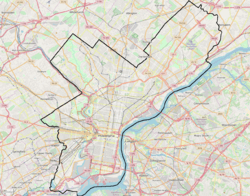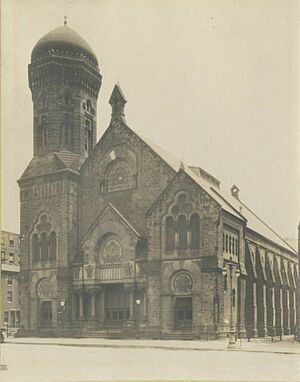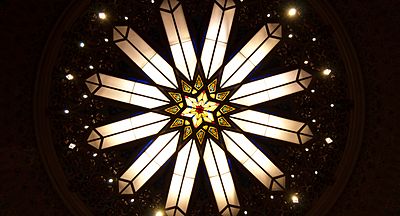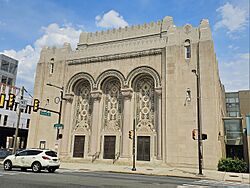Congregation Rodeph Shalom (Philadelphia) facts for kids
Quick facts for kids Congregation Rodeph Shalom |
|
|---|---|
|
Hebrew: רודף שלום
|
|
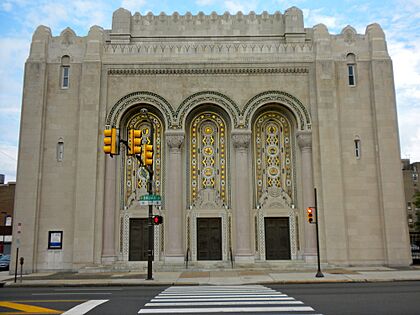
Rodeph Shalom Synagogue in 2010
|
|
| Religion | |
| Affiliation | Reform Judaism |
| Ecclesiastical or organizational status | Synagogue |
| Leadership |
|
| Status | Active |
| Location | |
| Location | 615 N. Broad Street, Philadelphia, Pennsylvania |
| Country | United States |
| Architecture | |
| Architect(s) |
|
| Architectural type | Synagogue |
| Architectural style |
|
| Date established | 1795 (as a congregation) |
| Completed |
|
| Specifications | |
| Direction of façade | West |
| Materials | Granite, synthetics, limestone |
Congregation Rodeph Shalom (which means "Pursuer of Peace" in Hebrew) is a historic Jewish community, or congregation, in Philadelphia, Pennsylvania. It is part of the Reform Judaism movement.
Started in 1795, it is the oldest Ashkenazic (Jews from Central and Eastern Europe) synagogue in the Western Hemisphere. The congregation is known for leading the Reform movement in America.
Its beautiful synagogue building on North Broad Street was built in 1928. The building has a unique mix of styles, including Byzantine, Moorish, and Art Deco. Because of its importance, it was added to the National Register of Historic Places in 2007.
Contents
Early History and Growth
Rodeph Shalom began in 1795 with a small group of ten Jewish worshipers from Germany, Holland, and Poland. The group officially created its rules in 1802. At first, it was a place for new immigrants. It was different from other synagogues because it offered lower membership fees to help people join.
The congregation also focused on helping others. Its rules allowed rabbis to give money to people who were sick or poor. However, members had to attend services on Friday nights and Saturday mornings, or they would have to pay a fine.
For its first 70 years, the congregation met in different rented spaces. Finally, in 1866, they built their first synagogue. It was designed by the famous Philadelphia architect Frank Furness in a Moorish Revival style.
In the early years, services were led by members of the congregation. The first official paid leader, or hazzan, was Rabbi Jacob Lippman. His salary was small, so he also ran a second-hand clothing store to support himself.
Becoming a Reform Synagogue
The 1800s were a time of big changes for Jewish communities in America. A new type of spiritual leader began to appear: a rabbi who had a university education. In 1853, Rodeph Shalom hired Rabbi Bernard L. Illoway, one of these new, highly educated rabbis.
Rabbi Marcus Jastrow's Leadership
In 1866, Rodeph Shalom invited Rabbi Marcus Jastrow from Warsaw, Poland, to be its leader. Jastrow was a respected scholar. He helped start a school for rabbis called Maimonides College, where he taught subjects like philosophy, history, and the Talmud (a central text of Judaism).
Rabbi Jastrow was also active in the community. He helped create the United Hebrew Charities, an organization that helped Jewish people in need. His interesting sermons attracted many new members. The congregation grew so much that in 1869, they built a larger synagogue.
Jastrow made some changes that moved the congregation toward Reform Judaism. He added a choir with both men and women, put an organ in the synagogue, and ended the separation of men and women in a special gallery.
However, by the 1890s, many people wanted even more changes. The Pittsburgh Platform of 1885 had laid out new ideas for Reform Judaism. It focused on modern science, morality, and social justice. Because Jastrow was seen as too traditional, he was replaced in 1892.
The Great Leaders of Reform
The period that followed brought two very important rabbis to Rodeph Shalom who shaped its future as a leading Reform congregation.
Rabbi Henry Berkowitz
In 1892, Rabbi Dr. Henry Berkowitz became the new leader. He was the first American-born rabbi in Philadelphia. He made many modern changes. He started a library, began publishing his sermons in English, and made studying German optional.
Rabbi Berkowitz believed in helping the wider community. He was part of a group that created playgrounds for children in poor neighborhoods. He also worked on a city commission to help immigrant girls. During World War I, he traveled to army camps to give lectures and raise money for war victims.
Rabbi Louis Wolsey
After Rabbi Berkowitz's death, Rabbi Louis Wolsey became the leader in 1925. He was a powerful speaker and a national figure. One of his first actions was to move the religious school into the main synagogue building.
Under Wolsey's leadership, the congregation built its current, magnificent synagogue in 1928. The building needed to be larger to hold all the members and provide space for offices and meetings. The beautiful interior, with its stained glass windows and decorated dome, was created by the D'Ascenzo Studio.
Like Berkowitz, Wolsey was a strong believer in social action. He started a center for children in the neighborhood and a clinic to teach young mothers about health and childcare. He also led a city commission that helped improve the state's justice system.
The Modern Era
From the mid-20th century to today, Rodeph Shalom has continued to grow and adapt under several dedicated rabbis.
Rabbi David H. Wice (1947–1981)
Rabbi David H. Wice led the congregation for over 30 years. During this time, many Jewish families moved from the city to the suburbs. To serve them, Rabbi Wice opened a Suburban Center in Elkins Park with its own religious school. He was also a leader in the international Progressive Jewish Movement, helping it grow around the world.
Recent Rabbis and Today
- Rabbi Richard S. Steinbrink (1981–1988) brought back some traditional rituals, like wearing a tallis (a prayer shawl). He encouraged the congregation to think about important public issues like world hunger and education.
- Rabbi Alan D. Fuchs (1988–1998) continued this tradition of community involvement. Before coming to Rodeph Shalom, he served as a US Army chaplain in Kentucky and France.
- Rabbi William I. Kuhn (1998–2017) encouraged members to volunteer their time to improve the community. Under his leadership, the synagogue's main sanctuary was restored in 2003–2004. In 2008, Barack Obama spoke at the synagogue during his campaign for president.
In 2017, Rabbi Jill L. Maderer became the Senior Rabbi, continuing the congregation's long history of leadership and service. The congregation remains active in supporting its community and has held events in support of Israel.
See also


